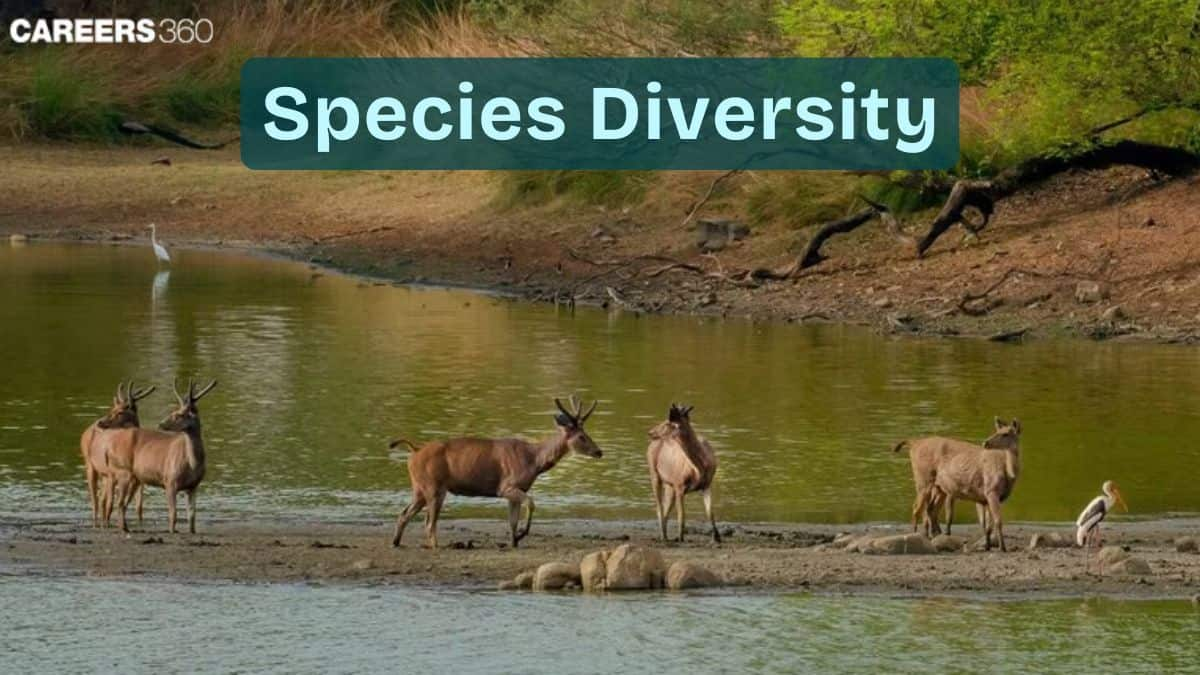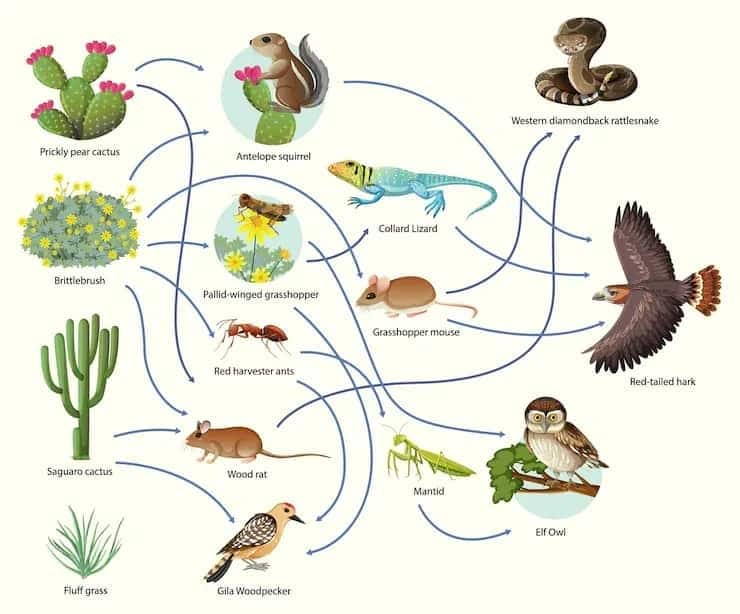Species Diversity: Definition, Importance, Examples, Types
Species diversity refers to the variety of species present in a particular ecosystem, including both species richness and species evenness. It plays a crucial role in maintaining ecosystem stability, productivity, and resilience to environmental changes. This guide explains species diversity, its measurement, importance, threats, and NEET-focused ecology concepts.

What Is Species Diversity?
Species diversity can thus be defined as the richness of the particular species existing in a given locality or environment. It refers to both, the number of species that is the species richness and the distribution of these species or species evenness. The diversity of species in a given ecosystem is very important because it increases efficiency in resource utilization, and nutrient cycling as well as the ability to adapt and respond to dynamic environments. Thus, proper species composition contributes to the ability of ecosystems to recover from disturbances and continue providing their functions.
Types of Biodiversity
Biological diversity is recognized as being of three major levels:
Genetic Diversity
Variation in the genetic material in a species
Enables evolution and adaptation.
Species Diversity
Variety of species within a habitat or ecosystem.
Ecosystem Diversity
Variety of ecosystems in geographical area
Measurement of Species Diversity
The measurement of species diversity is explained below-
Species Richness
Species richness is the total number of species in a given geographical area.
For instance, within a small sample of a forest, the species density could be defined by the number of plant species present.
Species Evenness
Species evenness determines to what extent the number of individuals is dispersed among different species in the designated community.
High evenness means stable ecosystem
Low evenness means dominance of one species
Importance Of Species Evenness
Complement the species richness by indicating the proportion of each species in the community.
Reflects sustainability of ecosystem
Importance of Species Diversity
The importance of Species Biodiversity is explained below-
Ecological Importance
measures the ability of ecosystems to produce stable food webs.
Supports nutrient recycling
Maintains pollination and predator-prey relationships.
Contribution in sustaining the functioning and the existence of other species.

Economic Importance
Habitat and species diversity offer such as food, medicine to human beings and raw materials.
Supports industries like agriculture and pharmacy.
Other ecosystems support recreation and tourism which forms the source of income for people within jurisdictions.
Cultural Significance
The diversity of species maintains the social history and culture of the original inhabitants of a particular area through communication with their environment.
The conservation of diverse species is vital since it supports practices which are passed down culturally as well as enriches one’s perception of the balance of power between humans and nature.
Threats To Species Diversity
The threats to Species Biodiversity is explained below-
Habitat Destruction
Habitat destruction continues to be a major difficulty in the conservation of species.
This is due to activities such as deforestation, urban and rural expansion and intensive farming.
These activities break up habitats, decrease the availability of resources, and push wildlife, which in turn decreases population and leads to the emergence of species extinction.
Climate Change
Global warming through increases in temperature
Changes in the pattern of rainfall
The rise in sea level poses great dangers to species that have adapted to certain conditions
Invasive Species
This is an invasion that is brought about by human factors such as the introduction of foreign plants and animals
This alters the food chain and ecosystem.
Some examples include the zebra mussel species in water streams and the lionfish species in the seas where they wreak havoc on other Indigenous species
Overexploitation
Overexploitation is the process by which certain species are hunted, caught, gathered or used at a rate which cannot be replenished.
Certain actions such as overfishing, poaching and deforestation reduce quantities and bring certain species to danger of extinction.
This endangers species diversity and affects the stability of ecosystems and their elements.
Case Study – Amazon Rainforest
The Amazon rainforest faces threats like clearing of forests for agriculture, logging, mining, especially by non-legal means and global warming. These pressures threaten numerous species suited to the specific ecosystems, it supports.
Conservation Efforts
Measures include securing conservancies, indigenous territories and sustainable use activities. Integrated initiatives focus on balancing the reduction of deforestation, advocacy for Indigenous people’s right to their land, and practices that ensure that the threat of climate change is checked through the preservation of the balance in the ecosystem.
Species Diversity NEET MCQs (With Answers & Explanations)
Important questions asked in NEET from this topic are:
Examples of abiotic factors
Major types of abiotic factors
Practice Questions for NEET
Q1. Which one of the following is most appropriately defined?
Host is an organism which provides food to another organism
Amensalism is a relationship in which one species is benefited whereas the other is unaffected
Predator is an organism that catches and kills other organism for food
Parasite is an organism which always lives inside the body of other organism and may kill it
Correct answer: 3) Predator is an organism that catches and kills other organism for food
Explanation:
During predation, an organism called a predator captures, kills, and eats another organism called prey. Predators are usually carnivores, but some herbivores that destroy whole plants/seeds are also called predators. In parasitism, one organism feeds on another organism, called the host. In amensalism, one species is suppressed while the others are neither favored nor suppressed. One organism suppresses another by secreting the same chemical without getting much benefit. This phenomenon is called the antimicrobial effect.
Hence, the correct answer is option 3) A Predator is an organism that catches and kills other organisms for food
Q2. Which of the following statement is incorrect w.r.t Paul Ehrlich
Ecologist at a Stanford University
Proposed ‘Rivet Popper hypothesis’
Shows the importance of species actually affects the extent of stability in the ecosystem.
Worked on outdoor plots for the hypothesis he proposed
Correct answer: 4) Worked on outdoor plots for the hypothesis he proposed
Explanation:
The role of biodiversity can be explained by the rivet popper hypothesis used by Stanford ecologist Paul Ehrlich. However, David Tilman’s long-term ecosystem experiments using outdoor plots provide some tentative answers to the significance of species diversity.
Hence, the correct answer is option 4) Worked on outdoor plots for the hypothesis he proposed
Q3. Which of the following endoparasites of humans does show viviparity?
Trichinella spiralis
Ascaris lumbricoides
Ancylostoma duodenale
Enterobius vermicularis
Correct answer: 1) Trichinella spiralis
Explanation:
An ailment known as trichinosis, which is characterised by muscle stiffness and discomfort, is brought on by the nematode parasite Trichinella spiralis. By eating the infected meat from the parasite larvae, another host can contract the parasite larvae. Trichinella spiralis, also known as the "pig worm," is frequently found in raw pork and several items that contain pork. Symptoms of trichinosis include fever, swelling, weakness, and gastrointestinal issues in severe cases. Proper cooking of pork and meat products is essential to prevent infection and reduce the risk of transmission.
Hence, the correct answer is option 1) Trichinella spiralis.
Also Read:
Recommended video for Species Diversity
Frequently Asked Questions (FAQs)
Species diversity is typically measured using metrics such as:
Species Richness: The total variety of species that live in one particular region.
Species Evenness: Their proportions in a community, which explains in a broad way how individuals are partitioned between species.
Several factors influence species diversity, including:
Environmental Factors: Resources such as food and water, structure of the habitat, and climate.
Biotic Interactions: Hunting, fighting for food and power and mutualistic behaviour.
Human Activities: Sustainable use of resources and maintain organism populations: Habitat fragmentation, destruction including for example deforestation, pollution of physical surroundings, introduction of alien species and overexploitation for commercial purposes.
Natural Events: Other factors include natural calamities including wildfires, floods and droughts that affect species diversity.
The primary threats to species diversity include:
Habitat Destruction: Deforestation to support such activities as farming and production of crops for food, expansion of cities and towns, and development of buildings and roads.
Climate Change: Changes habitats and the life cycle of the species, which will cause a change in species distribution and potentially some species could be made extinct.
Invasive Species: They can replace native species in their access to the resources due to the invasive nature of non-native species.
Overexploitation: Excessive hunting or fishing and over-exploitation of species mean that particular species will be rendered extinct.
Conservation efforts focus on:
Protected Areas: Setting out and consolidating forests, wildlife and reserves for the protection of plant and animal life.
Conservation Programs: Efforts to put into practice some of the biological plans formulated to ensure realization of species conservation, restoration of broken habitats as well as biological nature conservation practices.
Legislation: Regulations of the legislation for the protection of species on the verge of extinction and their habitats.
Community Involvement: Participating in local communities in conservation programs, encouraging the adoption of sustainable measures, and sensitising the public on the need to embrace the conservation of species diversity.